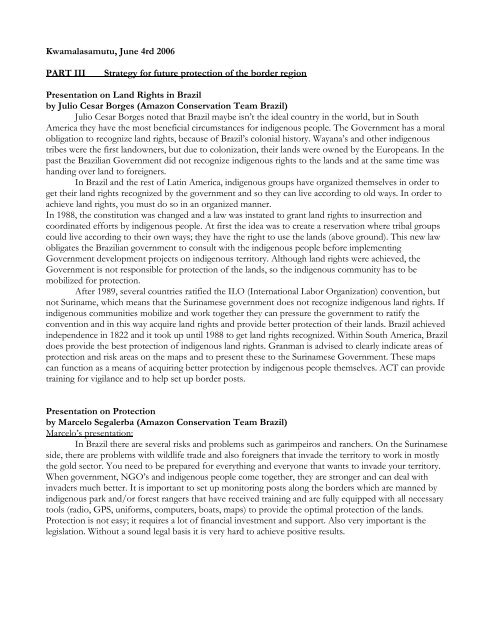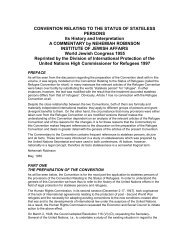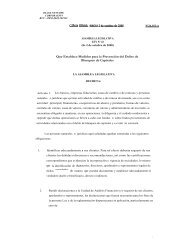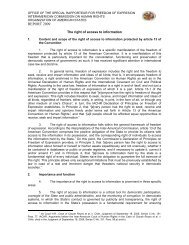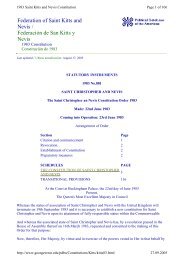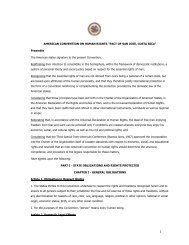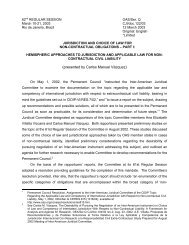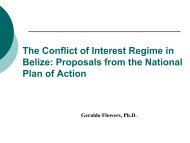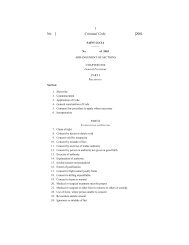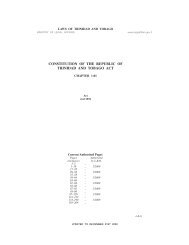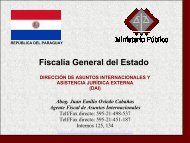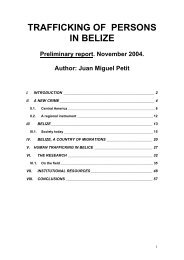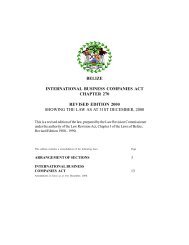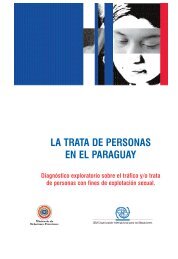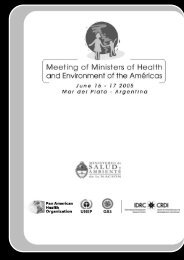Transboundary meeting on environmental protection
Transboundary meeting on environmental protection
Transboundary meeting on environmental protection
You also want an ePaper? Increase the reach of your titles
YUMPU automatically turns print PDFs into web optimized ePapers that Google loves.
Kwamalasamutu, June 4rd 2006<br />
PART III Strategy for future protecti<strong>on</strong> of the border regi<strong>on</strong><br />
Presentati<strong>on</strong> <strong>on</strong> Land Rights in Brazil<br />
by Julio Cesar Borges (Amaz<strong>on</strong> C<strong>on</strong>servati<strong>on</strong> Team Brazil)<br />
Julio Cesar Borges noted that Brazil maybe isn’t the ideal country in the world, but in South<br />
America they have the most beneficial circumstances for indigenous people. The Government has a moral<br />
obligati<strong>on</strong> to recognize land rights, because of Brazil’s col<strong>on</strong>ial history. Wayana’s and other indigenous<br />
tribes were the first landowners, but due to col<strong>on</strong>izati<strong>on</strong>, their lands were owned by the Europeans. In the<br />
past the Brazilian Government did not recognize indigenous rights to the lands and at the same time was<br />
handing over land to foreigners.<br />
In Brazil and the rest of Latin America, indigenous groups have organized themselves in order to<br />
get their land rights recognized by the government and so they can live according to old ways. In order to<br />
achieve land rights, you must do so in an organized manner.<br />
In 1988, the c<strong>on</strong>stituti<strong>on</strong> was changed and a law was instated to grant land rights to insurrecti<strong>on</strong> and<br />
coordinated efforts by indigenous people. At first the idea was to create a reservati<strong>on</strong> where tribal groups<br />
could live according to their own ways; they have the right to use the lands (above ground). This new law<br />
obligates the Brazilian government to c<strong>on</strong>sult with the indigenous people before implementing<br />
Government development projects <strong>on</strong> indigenous territory. Although land rights were achieved, the<br />
Government is not resp<strong>on</strong>sible for protecti<strong>on</strong> of the lands, so the indigenous community has to be<br />
mobilized for protecti<strong>on</strong>.<br />
After 1989, several countries ratified the ILO (Internati<strong>on</strong>al Labor Organizati<strong>on</strong>) c<strong>on</strong>venti<strong>on</strong>, but<br />
not Suriname, which means that the Surinamese government does not recognize indigenous land rights. If<br />
indigenous communities mobilize and work together they can pressure the government to ratify the<br />
c<strong>on</strong>venti<strong>on</strong> and in this way acquire land rights and provide better protecti<strong>on</strong> of their lands. Brazil achieved<br />
independence in 1822 and it took up until 1988 to get land rights recognized. Within South America, Brazil<br />
does provide the best protecti<strong>on</strong> of indigenous land rights. Granman is advised to clearly indicate areas of<br />
protecti<strong>on</strong> and risk areas <strong>on</strong> the maps and to present these to the Surinamese Government. These maps<br />
can functi<strong>on</strong> as a means of acquiring better protecti<strong>on</strong> by indigenous people themselves. ACT can provide<br />
training for vigilance and to help set up border posts.<br />
Presentati<strong>on</strong> <strong>on</strong> Protecti<strong>on</strong><br />
by Marcelo Segalerba (Amaz<strong>on</strong> C<strong>on</strong>servati<strong>on</strong> Team Brazil)<br />
Marcelo’s presentati<strong>on</strong>:<br />
In Brazil there are several risks and problems such as garimpeiros and ranchers. On the Surinamese<br />
side, there are problems with wildlife trade and also foreigners that invade the territory to work in mostly<br />
the gold sector. You need to be prepared for everything and every<strong>on</strong>e that wants to invade your territory.<br />
When government, NGO’s and indigenous people come together, they are str<strong>on</strong>ger and can deal with<br />
invaders much better. It is important to set up m<strong>on</strong>itoring posts al<strong>on</strong>g the borders which are manned by<br />
indigenous park and/or forest rangers that have received training and are fully equipped with all necessary<br />
tools (radio, GPS, uniforms, computers, boats, maps) to provide the optimal protecti<strong>on</strong> of the lands.<br />
Protecti<strong>on</strong> is not easy; it requires a lot of financial investment and support. Also very important is the<br />
legislati<strong>on</strong>. Without a sound legal basis it is very hard to achieve positive results.


